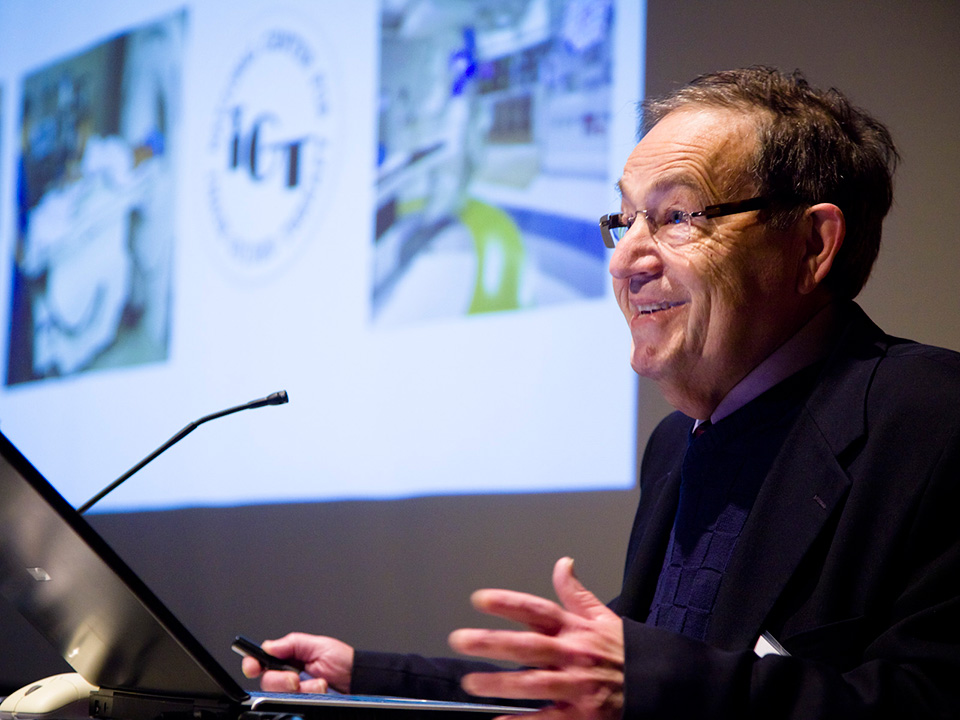A glimpse of tomorrow's medicine
By Alisa Kim
On November 10, 2011 researchers, trainees and staff gathered for the second annual Centre for Research in Image-Guided Therapeutics (CeRIGT) Research Day at Sunnybrook Research Institute (SRI).
The event showcased the science of CeRIGT, a $160-million centre that will add more than 150,000 square feet of research facilities to SRI. Here, scientists and their teams will create tools to detect and diagnose disease sooner and more accurately, invent technologies to treat disease minimally invasively, and develop biological and drug therapies tailored to the individual.
Dr. Barry McLellan, president and CEO of Sunnybrook, opened the day by recounting milestones in establishing CeRIGT. So far, these include the building of the magnetic resonance imaging (MRI)-guided high-intensity focused ultrasound surgery suite, the biomarker imaging research lab and the biomedical imaging research suite. He congratulated all involved in CeRIGT on the "hat trick," and invited everyone to the launch of the suite later that day.
Next, Dr. Michael Julius, vice-president of research at Sunnybrook, welcomed attendees and commended them for their role in fulfilling SRI's mandate of translating research into clinical impact for the benefit of patients. "The care on which we rely doesn't come out of thin air; it rests squarely on your shoulders, your dedication, your calling. Today's treatments are yesterday's discoveries," he said.
Julius noted that in addition to the $74 million investment from the federal government through the Canada Foundation for Innovation, the centre would not exist without the backing of the hospital's senior leadership and Board of Directors. "Sunnybrook Research Institute is a part of Sunnybrook Health Sciences Centre, and one cannot separate the successes of one from the successes of the other," he said.
Dr. Ferenc Jolesz, codirector of the National Center for Image Guided Therapy at Brigham and Women's Hospital (BWH) in Boston, gave the keynote lecture. Jolesz described BWH's Advanced Multimodality Image Guided Operating (AMIGO) suite, a medical and surgical research environment that allows multidisciplinary teams to treat patients using intraoperative, multimodality imaging without the patient or medical team ever leaving the operating room.
In AMIGO, one imaging modality offsets the weakness of another. Thus, X-ray and ultrasound, which produce images in real time, are combined with cross-sectional digital imaging systems like computed tomography (CT), MRI and positron emission tomography, which provide better definition. An exciting clinical application of AMIGO is molecular image-guided therapy through optical imaging and mass spectrometry. The improved sensitivity and specificity of images obtained from these probes provide greater definition of tumour margins, enabling clinicians to more thoroughly remove or destroy cancerous tissue, thus reducing rates of reoperation.
Following this, SRI researchers gave talks on how advances in imaging can more effectively detect and treat diseases of the musculoskeletal system, heart and brain.
From the Odette Cancer Research Program, Dr. Anne Martel a senior scientist in physical sciences at SRI, spoke on the use of dynamic contrast enhanced-MRI to assess the therapeutic response of tumours. Dr. Martin Yaffe, also a senior scientist in physical sciences and head of SRI's biomarker imaging research lab, discussed his work on quantitative pathology in cancer research and care.
Martel and Yaffe, along with other scientists and clinician-scientists at Sunnybrook, will work together in the treatment planning, analysis and evaluation facility, one of four platforms within CeRIGT. Here, work in image registration and analysis techniques will provide insight into the molecular nature of disease and guide the development of new, targeted therapies.
The event also featured the unveiling of the biomedical imaging research suite. McLellan noted that the state-of-the-art facility, which enables researchers to do preclinical and clinical studies using MRI, CT and focused ultrasound, has fostered scientific collaboration and partnerships with industry.
Attendees made their way to S wing for a cake-cutting and a tour of the suite by lab members from various research groups who demonstrated how the equipment is being used by SRI scientists. [For more on the launch of the biomedical imaging research suite, read this story.]
The day concluded with remarks from Dr. Kullervo Hynynen, director of the physical sciences platform at SRI and the project lead of CeRIGT. Hynynen looked ahead to next year's CeRIGT Research Day and the completion of the whole centre, set for April 2012. "Then we'll just need to fill the space," he said.
To view presentations from this year's CeRIGT Research Day, click here.



